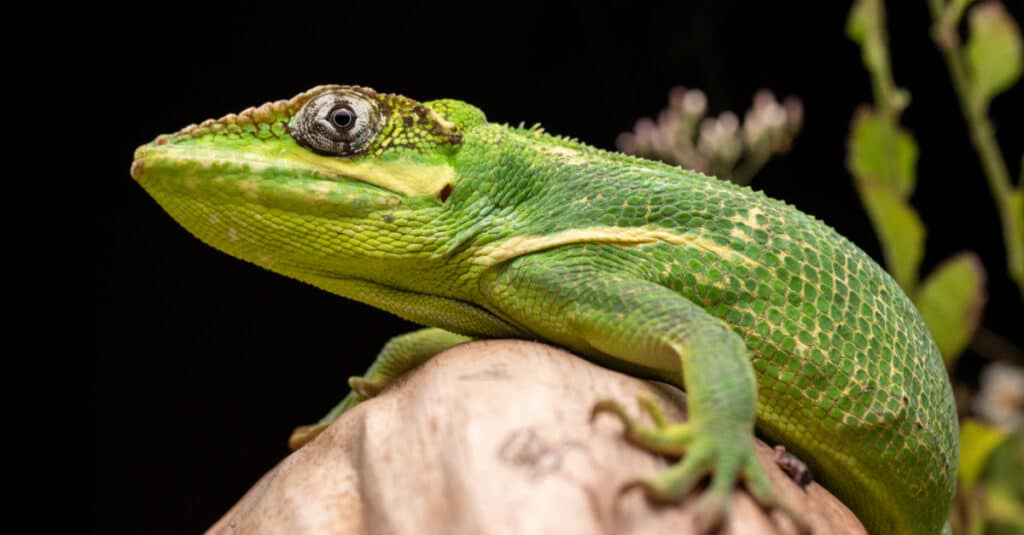Knight Anole
Anolis equestris
When threatened, the promiscuous knight anole rises on all fours and turns bright green, and gives a menacing look.
Advertisement
Knight Anole Scientific Classification
- Kingdom
- Animalia
- Phylum
- Chordata
- Class
- Reptilia
- Order
- Squamata
- Family
- Dactyloidae
- Genus
- Anolis
- Scientific Name
- Anolis equestris
Read our Complete Guide to Classification of Animals.
Knight Anole Conservation Status
Knight Anole Facts
- Prey
- Insects, snails, rodents, reptiles
- Main Prey
- Insects and snails
- Name Of Young
- Hatchling
- Group Behavior
- Largely solitary
- Fun Fact
- When threatened, the promiscuous knight anole rises on all fours and turns bright green, and gives a menacing look.
- Estimated Population Size
- Unknown
- Biggest Threat
- Snakes and birds
- Most Distinctive Feature
- Knight anoles are the largest of the anoles
- Distinctive Feature
- Knight anoles are bright green, but can change to brown with yellow patterns.
- Other Name(s)
- Cuban knight anole, Cuban giant anole
- Temperament
- Aggressive
- Incubation Period
- 45 days
- Habitat
- Arboreal, but may also be found on rocks, asphalt, or sidewalks
- Diet
- Omnivore
- Average Litter Size
- 1
- Lifestyle
- Diurnal
- Favorite Food
- Insects
- Type
- Reptile
- Common Name
- Knight Anole
- Special Features
- pinkish-white dewlaps
- Origin
- Cuba
- Number Of Species
- 1
- Location
- Cuba, Florida
- Average Clutch Size
- 1
Knight Anole Physical Characteristics
- Color
- Yellow
- Green
- Skin Type
- Scales
- Lifespan
- 8–10 years
- Weight
- 0.56–4.83 ounces
- Length
- 13–20 inches
- Age of Sexual Maturity
- 2 years
- Venomous
- No
- Aggression
- Medium
View all of the Knight Anole images!
When threatened, the promiscuous knight anole rises on all fours, turns bright green, and gives a menacing look.
Summary
Knight anoles are the largest anole species. An average anole can grow to be as long as 20 inches. The vertebrates were originally natives of Cuba but have been introduced to Florida. They are quite common and are bigger than the green and brown anoles most people in Florida are familiar with. Knight anoles are fiercely territorial. They are bold and tend to face any perceived threat rather than back down.
5 Knight Anole Facts
- When threatened, knight anole will stand on all fours and turn green
- Knight anoles cannot withstand cold temperatures
- They are sometimes mistaken for the green iguana, so they are called “iguanas” or “iguanitos” in Florida.
- The knight anole is a polygynandrous animal, meaning that they entertain multiple sexual mates in a single breeding season.
- Adult knight anoles have a varied diet that includes animals and fruits.
Knight Anole Scientific Name
The scientific name of the knight anole is Anolis equestris. It belongs to the genus Anolis, while the common name ‘equestris’ is a Latin word that means ‘mounted.’ It is also commonly called Cuban knight anole or Cuban giant anole in reference to its native country. In Cuba, the lizard is known by the native name “chupacocote.”
It belongs to the Dactyloidae family. Anolis equestris belongs to a group of anoles called the equestrus species complex. They are grouped together because of the remarkable similarities in their appearance, behavior, and ecomorphs. The other species in the equestrus species complex are:
- Anolis baracoae,
- Anolis luteogularis
- Anolis noblei
- Anolis pigmaequestris
- Anolis smallwoodi
Knight Anole Appearance

Although this
lizard is primarily green
, it can change its color to light brown depending on its mood and the environment.
©Radiant Reptilia/Shutterstock.com
The knight anole is the largest species of anole. It has a large, bony head that can be likened to the knight piece in chess, hence its name. This lizard can grow to a length of up to 20 inches, longer than the green and brown anoles. They typically weigh between 0.56 and 4.83 ounces.
They are sexually dimorphic, with the male anoles tending to be larger than the female species. The snout-tail length for an average male is typically between 3.9 and 7.5 inches, while that of the female is around 3.5–6.3 inches. In both males and females, their tails are longer than their bodies bringing the total length of the lizard to about 13–20 inches.
Knight Anole Behavior
Although this lizard is primarily green, it can change its color to light brown depending on its mood and the environment. The color of the young anole is a lighter shade, and they often have color bands. The anole has several teeth which are small and sharp, with which they can deliver painful bites.
Knight anoles are diurnal. A group of anoles is called a “lounge.” However, they are rarely found in groups because they’re mostly solitary and territorial. When a perceived threat approaches, the knight anole puts up an elaborate display. They sit high on their four limbs to create a menacing look. They also change color and bob their heads at the intruder. This lizard can also puff itself up while males extend their dewlap.
Interestingly, They are less aggressive in captivity. But that’s not to say they’re completely docile. The knight anole does not like to be held and can deliver a painful bite. However, if they have been raised from birth, they can be gentle enough to be held by the people they’re familiar with.
Knight Anole Habitat
This lizard is native to Cuba and was introduced to Florida in 1957. The introduction happened in Miami-Dade County, Florida. The eventual spread of this species to other counties in Florida has been speculated to be both natural and human-assisted. As a result, they are now widespread in the southern Florida region. Another speculation made about the cause of the spread is the possibility of their escape from careless owners in Florida, after which they begin to multiply rapidly.
They are arboreal animals that live at altitudes ranging from near sea level to about 3,300 feet. Their natural habitat has many trees, and they spend a lot of time up the trees. Sometimes they move from one tree to the other or to the ground to thermoregulate. You may also find this lizard on rocks, asphalt, or sidewalks. In addition to forest habitats, the knight anole lives in mangroves, savannas, and cultivated gardens.
The species is not built to withstand cold. It is a popular sight to see them freeze and fall to the ground from trees during winter in Florida. Although they’re largely solitary, you may find them huddled together for heat during cold seasons.
Knight Anole Diet
Knight anoles are mostly carnivores. The diet of the young knight anole is mainly insects when they are still young. However, older anoles have a more varied diet, including invertebrates such as snails or even fruits. They may even eat vertebrates like small birds, frogs, and other reptiles (including other anoles).
Knight Anole Threats and Predators
The invasive knight anoles can reproduce and multiply at a very fast rate. This makes them a threat to other species as they saturate and dominate limited space and resources. They are not near extinction since they can multiply quickly with minimal effort.
Snakes and birds are their most common predators. Larger anoles may also prey on juveniles. Their population is currently not under threat.
Knight Anole Reproduction, Babies and Lifespan
Anolis equestris is polygynandrous. This implies that the male and female anoles have more than one reproductive partner in one breeding season. The species are oviparous, and they reproduce during the summer.
Their behavior during the mating season tends to be similar to how they behave when they feel threatened. The males frequently nod their heads. They also expand and contract their dewlaps as a sort of mating display.
After mating, the female Cuban giant anole lays eggs about an inch in length after every 10 days. The young anoles hatch out of their eggs after 45 days. Juveniles look similar to adults but are smaller and more lightly colored. The hatchlings are usually 2-5 inches long. Young anoles are self-sufficient from birth, and adults don’t exhibit any parental care.
The lifespan of the Cuban knight anole is a function of how well they are treated. They tend to live longer when they regularly feed on insects and bugs. They can live as long as 10 years in captivity with quality care.
Knight Anole Population
The current population trend of the knight anole is unknown. However, they have been assessed by the IUCN to be a Least Concern animal. This means that they do not currently face any population threat and are abundant in the wild They have extended beyond the shores of their native country (Cuba) and are now found across Florida, with a stable population.
Related Animals
View all 77 animals that start with KKnight Anole FAQs (Frequently Asked Questions)
Are knight anoles venomous?
No. Although the Cuban knight anole delivers a very painful bite, their bite is not venomous. Their bite is painful, and medical care may be needed on the rare occasions when they bite.
Do knight anoles carry diseases?
Reptiles like the knight anole generally may carry some known zoonoses. Salmonella infection is the most common disease they spread. However, for those that intend to keep them as pets, it is important to practice good hygiene as this eliminates most risks associated with coming in contact with the species.
Are knight anoles carnivores?
Adult knight anoles are omnivorous. Although they primarily feed on insects and small lizards, they also occasionally eat fruits.
Thank you for reading! Have some feedback for us? Contact the AZ Animals editorial team.
Sources
- Animalia, Available here: https://animalia.bio/knight-anole
- Wikipedia, Available here: https://en.wikipedia.org/wiki/Knight_anole
- Animal Diversity Web / University of Michigan / Museum of Zoology / Jennifer Niederlander, Available here: https://animaldiversity.org/accounts/Anolis_equestris/

















